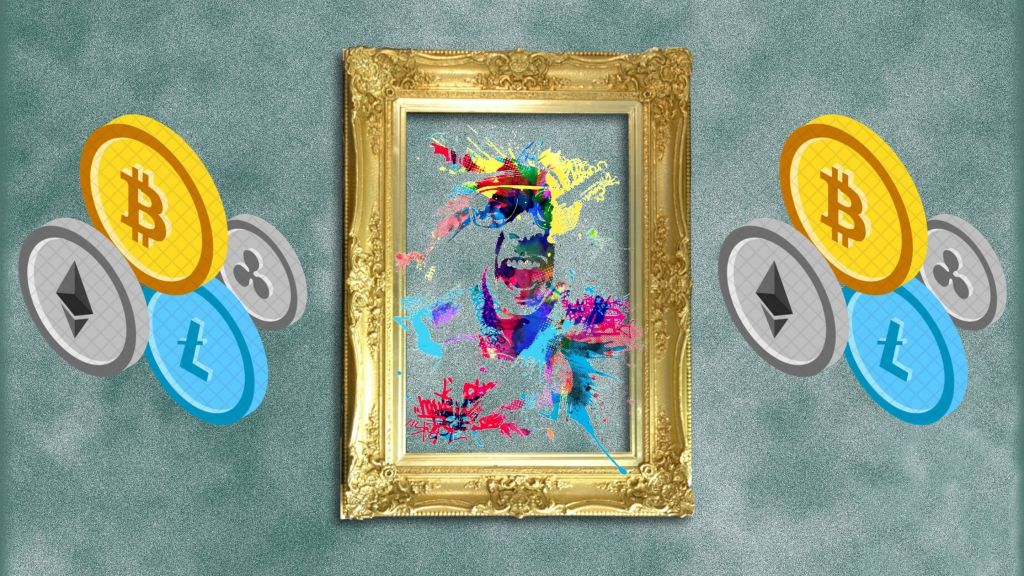Over the past month, people with crypto to burn have spent more than $60 million on NFT art: digital artwork linked to a unique kind of cryptocurrency called a “non-fungible token.” Each NFT token represents one particular digital artifact, and is coded in a way that proves the holder owns the true, original copy of that artifact (instead of, say, a screenshot of it). NFTs can’t be forged, stolen, or duplicated, due to the way they’re manufactured on the blockchain. Additionally, they’re not interchangeable; unlike dollars, bars of gold, or bitcoins, they don’t have a standardized common value, so they can’t be swapped one-for-one.
Those who have bought into the NFT art craze—quite literally, by shelling out thousands if not hundreds of thousands of dollars on individual NFTs—aren’t just convinced that the art they buy is actually worth what they paid for it; they believe it’s going to go up in value over time. These pieces are groundbreaking, the thinking goes—foundational entries in the nascent canon of digital art. But digital art isn’t a new medium; it’s been around since the 1960s. And according to digital art curators who spoke with VICE, most of the NFT art on the market pales in comparison to what the broader world of digital art has to offer.
Videos by VICE
“I think many [NFT artworks] will end up being hopelessly overpriced,” Christiane Paul, a curator of new media arts at the Whitney Museum of American Art and a professor of media studies at the New School, told VICE. “What I’ve seen billed as ‘art’ in so many of these NFT articles I find a little horrifying.”
Most NFT artworks tend to be digital drawings, animations that play on a loop, or otherwise relatively basic computer-generated renderings. That’s not to say they aren’t interesting to look at, or even beautiful—certainly, lots of them are. But for the most part, NFT art is nothing new, Paul said. Digital artists have created interactive sculptures of the entire known universe, videos broken up into thousands of individual, privately held pixels, and augmented reality forests—made up of actual, living trees—that own and manage themselves. When work like that exists, Paul finds it baffling that people are so fixated on digital art that’s far less expansive.
“I have not seen anything that is absolutely groundbreaking compared to digital art in general,” Paul said. “By nature, these do not tend to be super involved pieces. It’s not super sophisticated software. It’s more like interesting little one-liners.”
There’s room for those making NFT art to grow, according to Chloë Diamond, a curator at the Museum of Contemporary Digital Art. As of now, most artists are using NFT as a sales mechanism more than a medium. A majority of these works don’t meaningfully engage with cryptocurrency as an idea, or use the blockchain as an integral part of their creative process.
“It’s rare that I see an artwork where I’m really blown away by the concept, or I’m really inspired by the way they’ve used the medium,” Diamond told VICE. “I personally want to see more artists really using this digital medium, and the potential of the internet as a medium, to create something that maybe we’d never have thought of before. To kind of mimic a canvas, I feel like it’s not really doing the medium justice.”
Both Paul and Diamond said that NFTs are, on the whole, a good thing for artists. Because of them, more digital art is being sold—for higher-than-average prices—to a broader pool of buyers. On top of that, artists can bake code into their NFTs that nets them a percentage of the sales price each time their work changes hands, typically between 2.5 and 10 percent. In the traditional art market, artists only profit from the sale of their work once. It’s also noteworthy, Diamond said, that virtually anyone with an internet connection can list their work on an NFT art exchange like NiftyGateway. In the world of fine art, the barrier to entry is far higher.
“You don’t need a gallery to validate you,” Diamond said. “You don’t need to have some authority saying, ‘Oh, you’re allowed to be an artist.’ In that way, it allows for artists to just take control.”
That said, just because almost anyone can participate in the NFT art market doesn’t mean everyone will succeed in it. It’s a stratified landscape, in which a small number of big-name artists like Beeple—who recently sold an NFT for $6.6 million—earn wild sums of money, while their lesser-known counterparts take home much smaller payouts, if anything at all.
“At the moment, it’s on the cusp of being dominated by a few very loud voices,” Diamond said. “There has been this concentration of wealth for a very small number of crypto artists, which has been problematic. If you’re spending millions on an artwork, it’s like, you could also support millions of artists with this money.”
NFTs are a promising new tool artists have at their disposal, Paul and Diamond said. They have the potential to help inspire innovative work, and to give a platform to countless artists who never had one before. But right now, Paul and Diamond said, we just aren’t there yet.
“I’d really like to see more stepping away from what’s familiar,” Diamond said. “With art in general, it’s always come back to these legacy problems of lack of diversity, favoring a particular type of artist over another, and it being really hard for new artists to break into the scene. I feel like crypto art and the NFT world would really benefit from being more aware of that, because then they can avoid repeating the same problems. They really have that potential. It just needs a little bit more critical engagement.”
Follow Drew Schwartz on Twitter.
More
From VICE
-

(Photo by Bryan Bedder/Getty Images) -

Screenshot: Ubisoft -

Isabel Pavia/Getty Images


